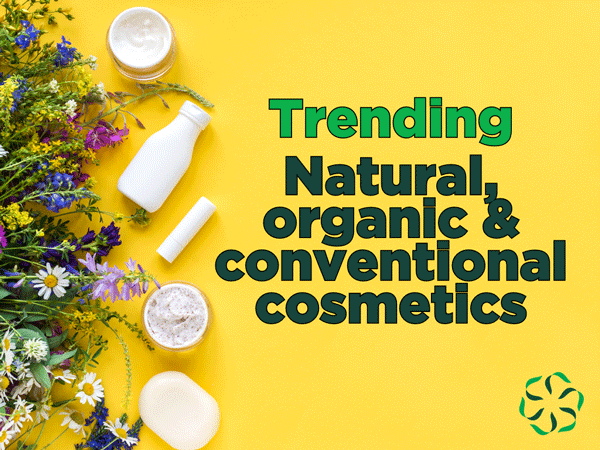There’s been a recent surge in all-natural and organic cosmetic products. In this post, we explore these labels and how they impact products.
Updated: June 3, 2022
What are cosmetics?
Cosmetics are the lotions, makeups, and other personal care products we use in our daily lives, such as lipstick, face lotion, powders, and more.
There are many types of cosmetic labeling and marketing. In this post, we’re exploring the natural, organic, and conventional cosmetic types.
What are natural cosmetics?
Typically, the term “natural” implies manufacturers do not use synthetically derived chemical ingredients when creating their products. Instead, scientists design the formula using naturally occurring chemical ingredients.
Regardless of the ingredient source, cosmetics are all formulated using chemical ingredients. It’s important to remember that everything is made up of chemicals.
What are organic cosmetics?
Organic describes ingredients grown, harvest, and processed in a way fitting the United States Agriculture Department’s (USDA) standards for organic agricultural products.
The USDA allows three types of organic labeling:
- 100% organic: meaning 100% of the product is produced from organic ingredients
- Organic: meaning at least 95% of the product is produced from organic ingredients
- Made with organic ingredients: meaning at least 70% of the product is produced from organic ingredients
Products containing less than 70% organic ingredients can still identify the organic ingredients in the ingredient list; however, manufacturers cannot claim the cosmetic product is organic.
Therefore, an organic cosmetic product will only contain organically sourced ingredients.
Does natural mean organic?
No, natural and organic are not interchangeable terms. Natural ingredients, meaning non-synthetically derived chemicals, can come from plants that are not organically grown.
What are conventional cosmetics?
Cosmetics that do not contain labels such as “natural” or “organic” are products using synthetic chemicals. Again, everything is made up of chemicals.
Manufacturers use synthetic chemicals in their formulations for many reasons, including their purity, stability, ability to source them, and more.
Are synthetic cosmetic ingredients dangerous?
A chemical ingredient created from synthetic sources is not automatically harmful. As with all ingredients, the dose makes the poison.
Additionally, the same requirements for safety and labeling apply to all cosmetics, no matter if the ingredients are synthetic, natural, or organic.
So, it’s important to use products as intended and to read labels to ensure you’re using a product correctly and at the right frequency (1,2).
If it’s discovered that a synthetic ingredient (or any ingredient) causes harm, the U.S. Food and Drug Administration (FDA) can and will ban the ingredient to prevent harm.
Are all-natural and organic cosmetic ingredients safe?
No, a natural or organic ingredient can cause harm. For example, all-natural vitamin-A found in many products can cause harm when consumed at high levels.
The natural and organic labels do not automatically mean safe. It’s essential to read labels and only use products as intended.
Are the claims regulated?
Currently, the FDA doesn’t have a regulatory definition for the term “natural” for cosmetic labeling. Additionally, the FDA doesn’t regulate the term organic. The USDA is responsible for organic certification and regulation.
However, manufacturers bear legal responsibility to make sure the cosmetic products they sell are safe for use and labeled appropriately (1,2).
The good news.
There are many excellent, safe cosmetic products on the market for us to explore. And, if we’re ever concerned about a cosmic ingredient, we can look up any ingredient for a science-based safety report at https://www.cir-safety.org/ingredients.
Researchers and the FDA continue to seek a deeper understanding of the safety of many cosmetic ingredients. They have created a form for us to share their experience or reaction to specific cosmetics. Gathering this information helps researchers and regulators to continue to learn and create effective policies.
If you have any questions about foods and ingredients, please reach out to us on Twitter, send us an email, or submit your idea to us at go.msu.edu/cris-idea.

